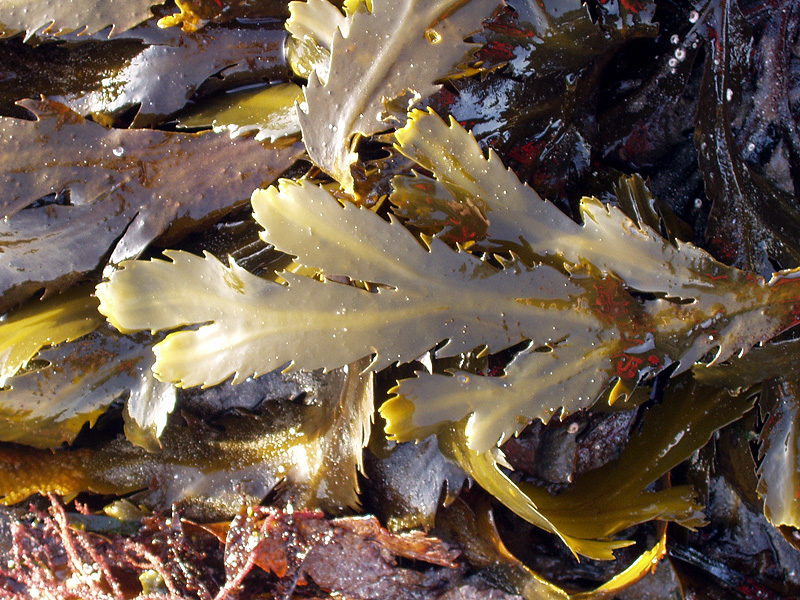- Fucus serratus
Taxobox | color = khaki
name = "Fucus serratus"
image_width = 250px

regnum =Protista
divisio =Heterokont ophyta
classis = Phaeophyceae
ordo =Fucales
familia =Fucaceae
genus = "Fucus "
species = "F. serratus"
binomial = "Fucus serratus"
binomial_authority = L.__NOTOC__"Fucus serratus" is aseaweed of the northAtlantic Ocean , known as toothed wrack or serrated wrack. [cite book |id=ISBN 0-86033-046-X |title=The book of seaweed |author=Alan P. Major |year=1977 |publisher=Gordon Cremonesi] It is olive–brown in colour and similar to "F. vesiculosus" and "Fucus spiralis ". It grows from a discoidholdfast . The fronds are flat, about 2 cm wide, bifurcating, and up to 1 m long including a short stipe. It branches irregularly dichotomously. The flattened blade has a distinct midrib and is readily distinguished from related taxa by the serrated edge of thefrond s. It does not have airvesicle s, such as are found in "F. vesiculosus", nor is it spirally twisted like "F. spiralis".The reproductive bodies form in
conceptacles sunken inreceptacles towards the tips on the branches. In these conceptacles oogonia andantheridia are produced and aftermeiosis the oogonia and anteridia are released. Fertilisation follows and thezygote develops, settles and grows directly into thediploid sporophyte plant.Distribution and ecology
"Fucus serratus" is found along the Atlantic coast of Europe from
Svalbard toPortugal , in theCanary Islands and on the shores of north-east America. Cite book |author=W. R. Taylor |year=1972 |title=Marine Algae of the Northeastern Coast of North America |publisher=University of Michigan Press |pages=520 pp |id=ISBN 0-472-08840-8] [cite web |url=http://www.algaebase.org/search/species/detail/?species_id=85&sk=0&from=results |title="Fucus serratus" Linnaeus |work=AlgaeBase |author=M. D. Guiry & Wendy Guiry |date=2006-11-23 ] It was introduced toIceland and theFaroes by humans within the last 1000 years where it was first noted in a phycological survey in 1900. It grows very well on slow draining shores where it may occupy up to a third of the area of the entire seashore. Cite journal |quotes=no |author = J. A. Coyer, G. Hoarau, M. Skage, W. T. Stam & J. L. Olsen |year=2006 |title=Origin of "Fucus serratus" (Hereokontophyta; Fucaceae) populations in Iceland and the Faroes: a microsatellite-based assessment |journal=European Journal of Phycology |volume=41 |issue=2 |pages=235–246 |doi=10.1080/09670260600652820] It often dominates the rocky parts of the lower shore, exposed or emersed in rock pools, on all but the most exposed shores. cite book |author=F. G. Hardy & M. D. Guiry |year=2006 |title=A Check-list and Atlas of the Seaweeds of Britain and Ireland |publisher=British Phycological Society , London |url=http://seaweed.ucg.ie/check-list/check-list.pdf |id=ISBN 0-9527115-1-6]Uses
"F. serratus" is used in
Ireland andFrance for the production ofcosmetics and forthalassotherapy .References
Wikimedia Foundation. 2010.
